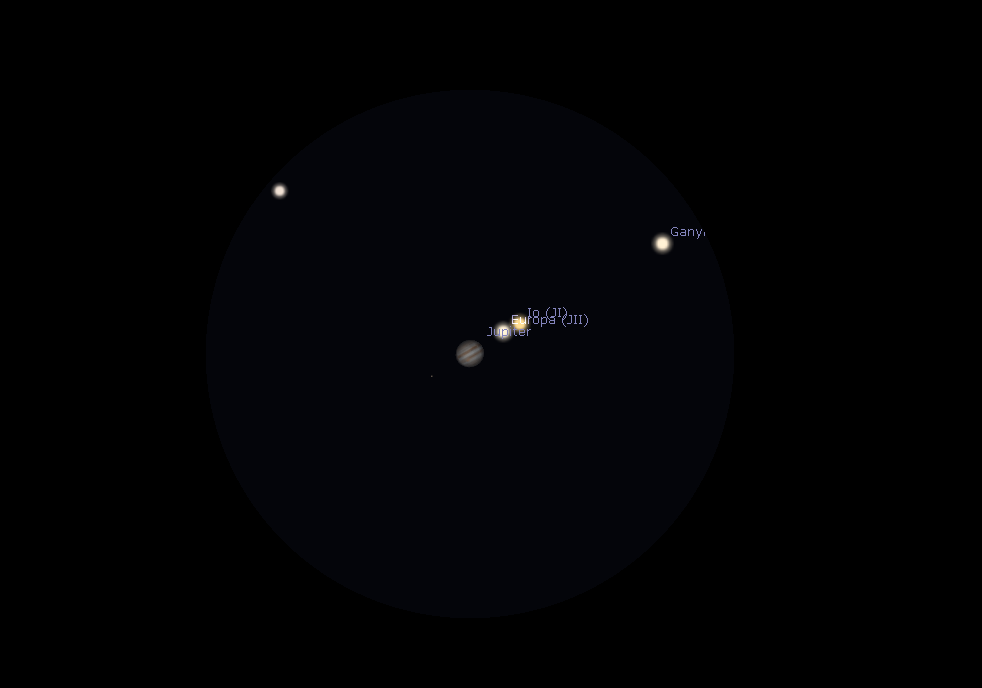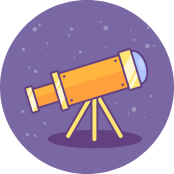Jupiter, the largest planet in the solar system, comes to opposition this summer. It’ll be the second brightest planet in the sky, next to Venus, shining brightly in the eastern sky after sunset in August and September. Jupiter is an incredible planet to observe in a telescope, with different telescopes revealing different details on both Jupiter and its four Galilean moons. This article will help you pick the best telescope to observe Jupiter in 2021.
Where should I look for Jupiter?
Throughout the summer, Jupiter will be visible in the constellation of Aquarius rising in the east shortly after sunset. It’s quite hard to miss, as it shines brightly at an apparent magnitude of -2.8, making it the brightest planet in the sky (next to Venus, which is visible to the west after sunset). Jupiter is brighter than any of the stars in the summer sky and will be hard to miss. Additionally, unlike stars, planets do not twinkle. Look for the bright white “star” in the southeast around 8-10 PM and you will have found Jupiter.
Should I use a tracking mount?
We strongly recommend using some sort of computerized mount to track Jupiter. At the high magnifications required to observe Jupiter, the Earth’s rotation becomes more apparent. You’ll find at magnifications higher than 50x that Jupiter may quickly zoom out of the field of view in a matter of a minute or so. This becomes more difficult at even higher magnifications. Without a tracking mount, you may only get a few second glimpse of Jupiter before the planet whizzes out of the field of view.
Understanding the limitations of the Atmosphere: Seeing and Transparency
As any amateur astronomer will quickly discover, the atmosphere is not static. Disturbances in the atmosphere, the positioning of the jet stream, and many other natural atmospheric phenomena can distort our view of the night sky. The main two factors that impact our view of the universe are seeing (how still the atmosphere is) and transparency (how transparent the atmosphere is to light). On some nights, after a cold front, for example, you might find that looking at Jupiter through an eyepiece is like looking at it through a pool of water. On nights like this, the resolution you’ll be able to see will be limited by as many as 5 arcseconds. To maximize your enjoyment of Jupiter on nights with bad seeing, the best thing to do is to wait until Jupiter is closer to the zenith (point of highest altitude in the sky) so that the light from Jupiter is traveling through less atmosphere. You may also need to limit your magnification by using a lower power eyepiece.
What can I see with a pair of binoculars?
Many are often surprised that you can pick up the four major moons of Jupiter with just a small pair of binoculars. These moons are Io, Europa, Ganymede, and Callisto. These are some of the largest moons in the solar system, with both Ganymede and Callisto being larger than Mercury. Even the tiniest of binoculars, such as the Celestron Outland 8x42 binoculars, will be able to pick up the four moons of Jupiter. Other great pairs of binoculars are the Celestron SkyMaster 8x56 Porro Prism Binoculars or the much larger Celestron SkyMaster 15x70 binoculars.
Observing Jupiter with a Telescope Aperture

To be able to observe cloud belts and the Great Red Spot, you’ll need a telescope with a relatively large native focal length (or the focal length of the telescope with no Barlow lens). However, telescopes over 100mm can be quite heavy and bulky to use, which is why a beginner or even an intermediate observer may prefer something smaller. The Sky-Watcher Evostar ProED 80mm doublet refractor is a fantastic telescope in this range to observe Jupiter; it has a relatively long focal length of 600mm. When paired with a 6mm or 8mm eyepiece, this can yield a magnification of 100x or 75x. This would be sufficient to observe one or two of the main cloud belts on Jupiter, as well as the Great Red Spot, in most seeing conditions.
Simulated view of Jupiter as seen at 100x magnification through a Sky-Watcher 80mm refractor.

To be able to observe cloud belts and the Great Red Spot, you’ll need a telescope with a relatively large native focal length (or the focal length of the telescope with no Barlow lens). However, telescopes over 100mm can be quite heavy and bulky to use, which is why a beginner or even an intermediate observer may prefer something smaller. The Sky-Watcher Evostar ProED 80mm doublet refractor is a fantastic telescope in this range to observe Jupiter; it has a relatively long focal length of 600mm. When paired with a 6mm or 8mm eyepiece, this can yield a magnification of 100x or 75x. This would be sufficient to observe one or two of the main cloud belts on Jupiter, as well as the Great Red Spot, in most seeing conditions.
Simulated view of Jupiter as seen at 100x magnification through a Sky-Watcher 80mm refractor.
Observing Jupiter with a Telescope 4-6” Aperture

This is the range where more “serious” detail can be seen. Through a telescope in this range, you will more clearly see the cloud belts on the surface of Jupiter (at least two, probably more). The Great Red Spot will be more apparent and will take on a salmon-red color. There are many telescopes that are great for this range, such as the Celestron NexStar 4SE, the Celestron NexStar 5SE, or the Celestron NexStar 6SE. These telescopes are “Schmidt-Cassegrains” and have a high native focal length and come with tracking mounts, making them ideal for visual observations of Jupiter in this aperture range. Another telescope that would be useful in this range is the Apertura DT6 Dobsonian Telescope. This telescope offers similar performance to the Celestron NexStar 6SE at a lower price point. However, this telescope does not come with a tracking mount, so you may find it difficult to track Jupiter at the magnification needed to really see significant detail.
Simulated view of Jupiter with a Celestron 5SE and a 6mm eyepiece. Note that more cloud bands are now visible.
Observing Jupiter with a Telescope 8-12” Aperture

At this aperture, Jupiter really begins to come alive. On a night with steady seeing, you’ll be able to spot at least a half-dozen of Jupiter’s cloud bands. You might even be able to pick up detail inside Jupiter’s Great Red Spot, as well as hints of other cyclonic disturbances on the planet. More dramatically, Jupiter’s moons should be able to easily resolve from star-like points to very tiny disks. A great telescope with a tracking mount is the Celestron NexStar 8SE. Another fantastic option is the Sky-Watcher 8” Flextube Dobsonian or the larger Sky-Watcher 10” Flextube. Larger telescopes than this are recommended for a beginner. Even more experienced observers may wish to invest in an observatory to house the telescope inside, instead of having to haul everything inside-and-out. A great computerized telescope in the higher end of this range is the Celestron CPC 11” Schmidt-Cassegrain.
Jupiter through an 11” Schmidt-Cassegrain and a 6mm eyepiece. This yields a magnification of roughly 466x.
Recommended Accessories
Color Filters
While you can certainly look at the planets without a filter on your eyepiece, the right planetary filter will bring out details and markings on the planet's surface or its cloud structure that would be faint or unnoticeable otherwise. Color filters used for planetary viewing screw onto the barrel end of an eyepiece or Barlow. Choose 1.25" color filters for 1.25" eyepieces and 2" color filters for 2" eyepieces. When observing Jupiter, use a blue filter (80A, 82A, or 38A) to enhance views of the Great Red Spot or to boost the boundaries between Jupiter's reddish belts and their adjacent bright zones. A yellow (8), orange (21), or red filter (23A or 25) will help bring out details that are bluish in color, such as the planet's atmospheric currents, the polar regions, and sections of the belt structure.
Barlows
A Barlow lens acts to extend the focal length of your telescope. For example, a 2x Barlow will change your telescope with a 1200mm focal length to a 2400mm focal length. This in turn increases the magnification. However, the downside to Barlows is that by adding another lens to your setup, you’re also adding more glass for the light to pass through. This will reduce the quality when compared to using a telescope with a higher native focal length.
Telescopes we don’t recommend to observe Jupiter
Not all telescopes are built the same. Some are built with a different purpose in mind. We do not recommend a telescope dedicated for wide field astronomy or astrophotography (telescopes with a focal length

Questions? Contact Us!
Still not sure which telescope and accessories to choose for your observation of Jupiter? Send a message to our non-commissioned product advisors! Our team of telescope experts are happy to point you in the right direction.



